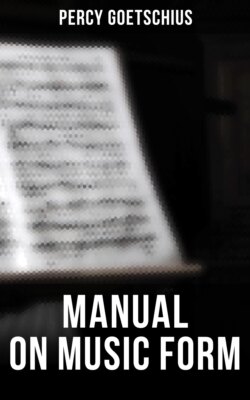Читать книгу Manual on Music Form - Percy Goetschius - Страница 10
На сайте Литреса книга снята с продажи.
CHAPTER II. FUNDAMENTAL DETAILS.
ОглавлениеTable of Contents
TIME.—Time is the same thing in music that it is everywhere else in nature. It is what passes while a piece of music is being played, sung, or read. It is like the area of the surface upon which the musical structure is to be erected, and which is measured or divided into so many units for this, so many for that, so many for the other portion of the musical Form. Time is that quantity which admits of the necessary reduction to units (like the feet and inches of a yardstick), whereby a System of Measurement is established that shall determine the various lengths of the tones, define their rhythmic conditions, and govern the co-operation of several melodies sung or played together. Time is the canvas upon which the musical images are drawn—in melodic lines.
TEMPO.—This refers to the degree of motion. The musical picture is not constant, but panoramic; we never hear a piece of music all at once, but as a panorama of successive sounds. Tempo refers to the rate of speed with which the scroll passes before our minds. Thus we speak of rapid tempo (allegro, and the like), or slow tempo (adagio), and so forth.
BEATS.—The beats are the units in our System of Measurement—as it were, the inches upon our yardstick of time; they are the particles of time that we mark when we "count," or that the conductor marks with the "beats" of his baton. Broadly speaking, the ordinary beat (in moderate tempo) is about equivalent to a second of time; to less or more than this, of course, in rapid or slow tempo. Most commonly, the beat is represented in written music by the quarter-note, as in 2–4, 3–4, 4–4, 6–4 measure. But the composer is at liberty to adopt any value he pleases (8th, 16th, half-note) as beat. In the first study in Clementi's "Gradus ad Parnassum," the time-signature is 3–1, the whole note as beat; in the 8th Sung Without Words it is 6–16, the sixteenth note as beat; in the last pianoforte sonata of Beethoven (op. 111), last movement, the time-signatures are 9–16, 6–16, and 12–32, the latter being, probably, the smallest beat ever chosen.
MEASURES.—A measure is a group of beats. The beats are added together, in measures, to obtain a larger unit of time, because larger divisions are more convenient for longer periods; just as we prefer to indicate the dimensions of a house, or farm, in feet or rods, rather than in inches.
Measures differ considerably in extent in various compositions, inasmuch as the number of beats enclosed between the vertical bars may be, and is, determined quite arbitrarily. What is known as a Simple measure contains either the two beats (heavy-light) of the fundamental duple group, or the three beats (heavy-light-light) of the triple group, shown in the preceding chapter. Compound measures are such as contain more than two or three beats, and they must always be multiplications, or groups, of a Simple measure; for whether so small as to comprise only the fundamental groups of two or three beats (as in 2–4, 3–8, 3–4 measure), or so large as to embrace as many as twelve beats or more (as in 4–4, 6–4, 6–8, 9–8, 12–8 measure), the measure represents, practically, either the duple or triple species, Simple or Compound. Thus, a measure of four beats, sometimes called (needlessly) quadruple rhythm, is merely twice two beats; the species is actually duple; the alternation of heavy and light pulses is regular; and therefore the third beat is again an accent, as well as the first, though less heavy. A measure of 6–8 is triple species, with accents at beats one and four, precisely as if an additional vertical bar were inserted after the third beat. In a word, then, the size of the adopted measure is of no consequence, as long as it is retained uniformly through the section to which it belongs; and there is no real difference between 2–4 and 4–4 measure, excepting in the number of bars used.
A curious and rare exception to this rule of the compound measure occurs when five or seven beats are grouped together. This involves a mingling of the duple and triple species, and, consequently, an irregular disposition of the accents; for instance, 5–4 measure is either 3+2 or 2+3 beats, with corresponding accentuation:
